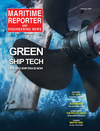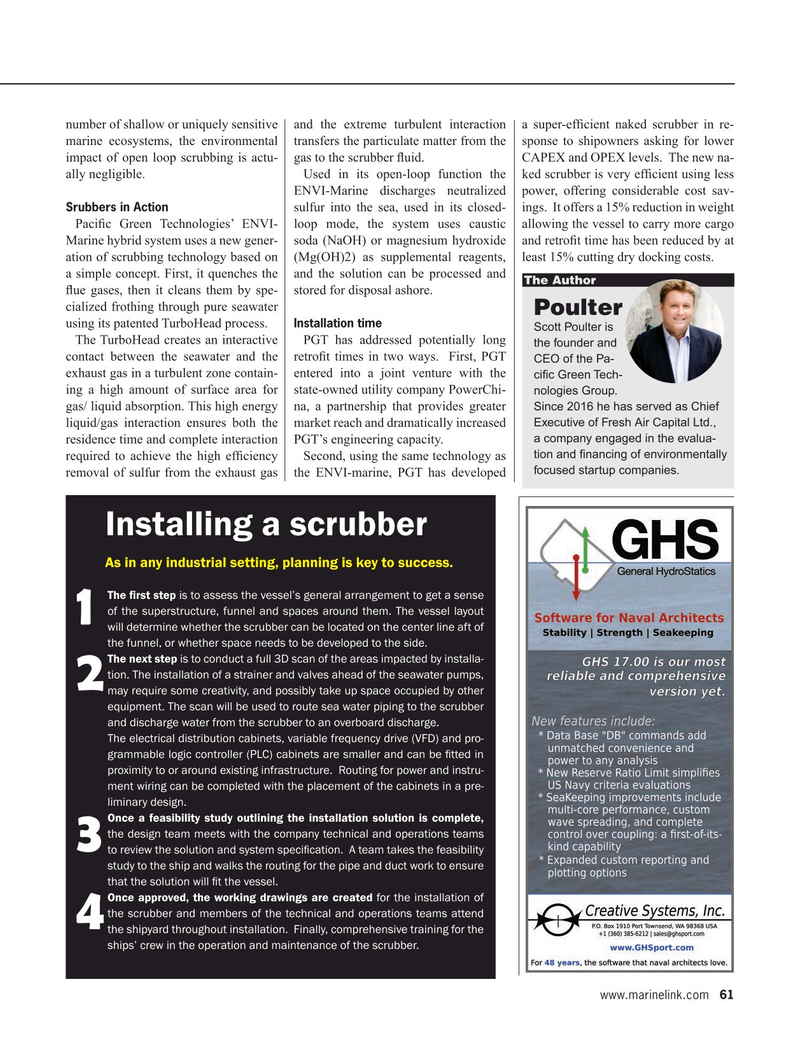
Page 61: of Maritime Reporter Magazine (February 2020)
Green Ship Technology
Read this page in Pdf, Flash or Html5 edition of February 2020 Maritime Reporter Magazine
number of shallow or uniquely sensitive and the extreme turbulent interaction a super-ef? cient naked scrubber in re- marine ecosystems, the environmental transfers the particulate matter from the sponse to shipowners asking for lower impact of open loop scrubbing is actu- gas to the scrubber ? uid. CAPEX and OPEX levels. The new na- ally negligible. Used in its open-loop function the ked scrubber is very ef? cient using less
ENVI-Marine discharges neutralized power, offering considerable cost sav-
Srubbers in Action sulfur into the sea, used in its closed- ings. It offers a 15% reduction in weight
Paci? c Green Technologies’ ENVI- loop mode, the system uses caustic allowing the vessel to carry more cargo
Marine hybrid system uses a new gener- soda (NaOH) or magnesium hydroxide and retro? t time has been reduced by at ation of scrubbing technology based on (Mg(OH)2) as supplemental reagents, least 15% cutting dry docking costs. a simple concept. First, it quenches the and the solution can be processed and
The Author ? ue gases, then it cleans them by spe- stored for disposal ashore. cialized frothing through pure seawater
Poulter using its patented TurboHead process. Installation time
Scott Poulter is
The TurboHead creates an interactive PGT has addressed potentially long the founder and contact between the seawater and the retro? t times in two ways. First, PGT
CEO of the Pa- exhaust gas in a turbulent zone contain- entered into a joint venture with the ci? c Green Tech- ing a high amount of surface area for state-owned utility company PowerChi- nologies Group. gas/ liquid absorption. This high energy na, a partnership that provides greater
Since 2016 he has served as Chief
Executive of Fresh Air Capital Ltd., liquid/gas interaction ensures both the market reach and dramatically increased a company engaged in the evalua- residence time and complete interaction PGT’s engineering capacity. tion and ? nancing of environmentally required to achieve the high ef? ciency Second, using the same technology as focused startup companies. removal of sulfur from the exhaust gas the ENVI-marine, PGT has developed
Installing a scrubber
As in any industrial setting, planning is key to success.
The ? rst step is to assess the vessel’s general arrangement to get a sense of the superstructure, funnel and spaces around them. The vessel layout 1 will determine whether the scrubber can be located on the center line aft of the funnel, or whether space needs to be developed to the side.
The next step is to conduct a full 3D scan of the areas impacted by installa- tion. The installation of a strainer and valves ahead of the seawater pumps, 2 may require some creativity, and possibly take up space occupied by other equipment. The scan will be used to route sea water piping to the scrubber and discharge water from the scrubber to an overboard discharge.
The electrical distribution cabinets, variable frequency drive (VFD) and pro- grammable logic controller (PLC) cabinets are smaller and can be ? tted in proximity to or around existing infrastructure. Routing for power and instru- ment wiring can be completed with the placement of the cabinets in a pre- liminary design.
Once a feasibility study outlining the installation solution is complete, the design team meets with the company technical and operations teams 3 to review the solution and system speci? cation. A team takes the feasibility study to the ship and walks the routing for the pipe and duct work to ensure that the solution will ? t the vessel.
Once approved, the working drawings are created for the installation of the scrubber and members of the technical and operations teams attend 4 the shipyard throughout installation. Finally, comprehensive training for the ships’ crew in the operation and maintenance of the scrubber. www.marinelink.com 61
MR #2 (50-65).indd 61 2/7/2020 10:36:18 AM

 60
60

 62
62
